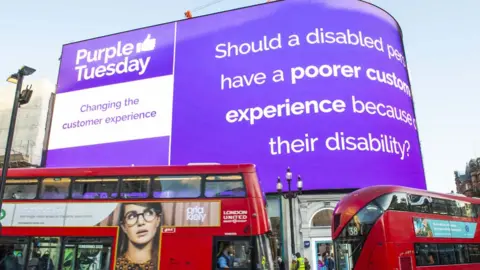Disability web access: 'I've already clicked away'
 BBC
BBCImagine entering all your details and payment card information online and then being unable to find the submit button to make a purchase.
For some using screen readers, owing to sight loss or impairment, that may be the case on some websites that do not label properly. Elsewhere, websites using capitals may lead to every letter being sounded out.
It does not take long for these potential customers to click away.
These are examples of the costs of failing to design websites that are accessible for people with disabilities and compatible with specialist software.
Campaigners at Purple, which aims to highlight the spending power of disabled people, said an estimated £11.8bn was lost every year in the resulting "click-away" costs.
"A lot of these things can be changed in 30 seconds," said Mike Adams, Purple's chief executive.
Born with a physical disability, Mr Adams uses dictation and a pen held in his mouth to operate his laptop computer.
"If a website is too much of an ordeal or time-consuming, then I've already clicked away," he said.
An awareness day - Purple Tuesday - is aiming to encourage businesses to sign up to an audit that should improve accessibility - physically and online - for disabled customers.
It said that the Purple Pound - spending by people with disabilities - was worth about £249bn to the UK economy this year. This figure was estimated to rise by 14% each year.
 Lucy Young
Lucy YoungThe organisation said that 75% of disabled people have had to leave a store or website, unable to go through with their purchase because of their disability. There are 13.9 million people with a disability in the UK, 80% of which are hidden impairments.
Some £420m a week was lost to businesses that fail to pay attention to these customers, Purple estimated, and online access was a growing part of this.
This might include poor mapping on websites, for those unable to operate a mouse, to the choice of colours that might affect those with colour blindness, Mr Adams said.
"You don't have to make your website boring. It might be something as simple as making text available in larger fonts," he said.
Lost sales could also come from a lack of information about access to and within physical stores, which might put off a disabled shopper from visiting.
He said the issues were found across sectors, from retail and travel to insurance and banking. He encouraged these businesses to seek advice, rather than trying to self-diagnose the effectiveness of their websites.
A range of businesses have done so already, introducing staff training, and changes to online and physical stores. Mr Adams said brand loyalty was very strong among people with disabilities once they find businesses they could trust and had confidence in dealing with.
